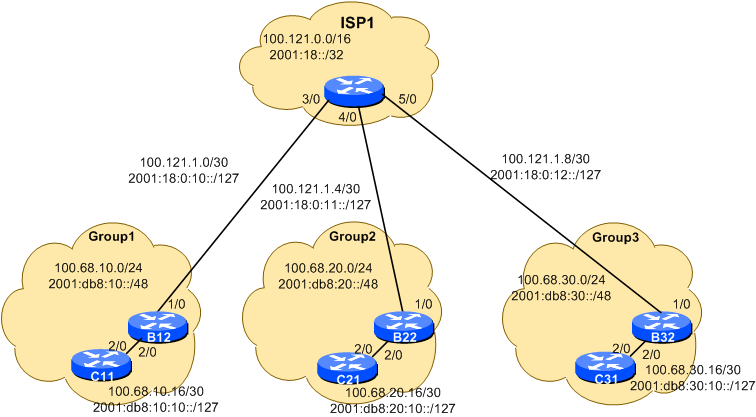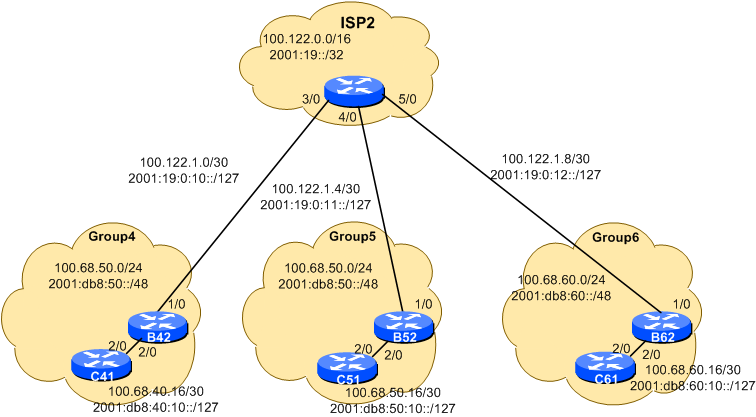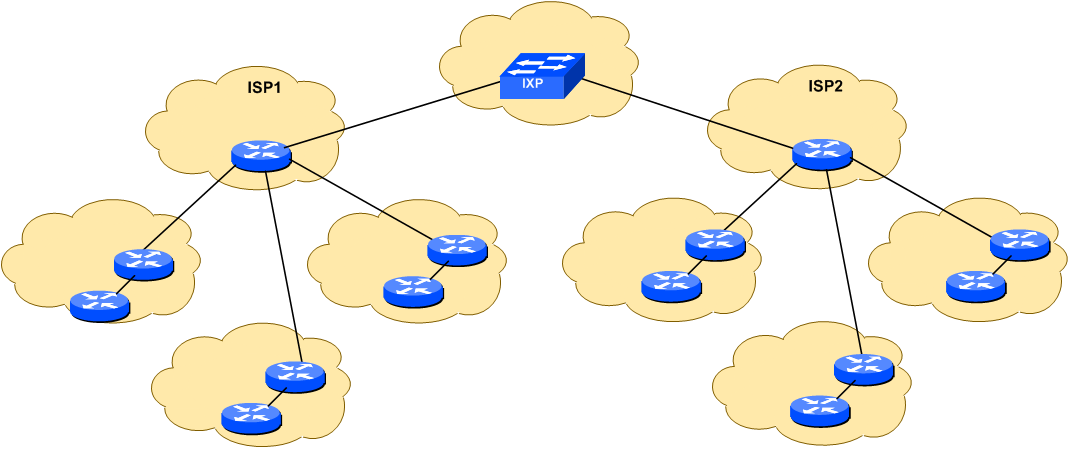Table of Contents
Basic Routing Lab
Introduction
The purpose of this exercise is to introduce participants to the basic configuration requirements of a Cisco router.
The network topology is designed to be modular to allow the lab to grow as needed depending on the number of participants. Each module in this lab contains 1 ISP and 3 customer networks (universities, etc). Modules will be interconnected.
Topology of Module 1
Module one is made up of three Groups (1,2,3), and their ISP. As we go through the workshop, we will add an NREN to this Module as well.
Topology of Module 2
Module two is made up of three Groups (4,5,6), and their ISP. As we go through the workshop, we will add an NREN to this Module as well.
Topology of the whole Lab
The entire workshop lab is interconnected as in the following diagram - the two ISPs interconnect via an Internet Exchange Point.
Logistics
Each participant will be assigned to a network. Depending on the number of participants, either a single person or a group will be responsible for the configuration of a router. You may be asked to rotate and work on a different router so that you have the opportunity to understand the network from another point of view.
As you go through the exercises, you will see examples of configurations for one or more routers. Make sure to take those examples and adapt them to your own router, network topology and addressing scheme. Use the diagrams to guide you.
Refer to the Lab Access Instructions document for information about logging into the routers that have been assigned to you.
Address Space Allocation
Refer to the IP Address Plan document for information about the IP address plan for the network infrastructure for these labs.
Basic Router Configuration
The following configuration examples show the suggested/recommended configuration to be implemented on the routers in each group. Replace the R in the examples with the router type (either B for Border or C for Core), and replace the X with your group number as appropriate.
Name the router
enable config terminal hostname RX1
Configure Authentication
aaa new-model aaa authentication login default local aaa authentication enable default enable username nsrc secret lab-PW enable secret lab-EN service password-encryption line vty 0 4 transport preferred none line console 0 transport preferred none
Configure logging
no logging console logging buffered 8192 debugging
Disable DNS resolution
no ip domain-lookup
Activate IPv6 routing
Turn on IPv6 Routing and activate IPv6 CEF (not on by default in Cisco IOS)
ipv6 unicast-routing ipv6 cef
Disable source routing for IPv4 and IPv6
no ip source-route no ipv6 source-route
Path MTU Discovery
Enable Path MTU Discovery on the router - this is not enabled by default for connections to the control plane (but it is enabled by default now for BGP).
ip tcp path-mtu-discovery
Exit configuration mode and save
end write memory
Interface Configuration
Links to other Routers
Configure your interfaces according to the diagram
Notice that for the links to the ISP we will use the ISP's addresses, while for internal links we use internal addresses.
On CX1:
interface GigabitEthernet2/0 description P2P Link to BX2 ip address 100.68.X0.17 255.255.255.252 no ip directed-broadcast no ip redirects no ip proxy-arp ipv6 address 2001:db8:X0:10::0/127 ipv6 nd prefix default no-advertise ipv6 nd ra suppress no shutdown !
On BX2:
interface GigabitEthernet2/0 description P2P Link to CX1 ip address 100.68.X0.18 255.255.255.252 no ip directed-broadcast no ip redirects no ip proxy-arp ipv6 address 2001:db8:X0:10::1/127 ipv6 nd prefix default no-advertise ipv6 nd ra suppress no shutdown
And the link to the ISP needs to be configured also, for example:
On B12:
interface GigabitEthernet1/0 description P2P Link to ISP1 ip address 100.121.1.2 255.255.255.252 no ip directed-broadcast no ip redirects no ip proxy-arp ipv6 address 2001:18:0:10::1/127 ipv6 nd prefix default no-advertise ipv6 nd ra suppress no shutdown !
Explanations for some of the commands used
no ip directed-broadcast
An IP directed broadcast is an IP packet whose destination address is a valid broadcast address for some IP subnet, but which originates from a node that is not itself part of that destination subnet.
Because directed broadcasts, and particularly Internet Control Message Protocol (ICMP) directed broadcasts, have been abused by malicious persons, we recommend disabling the ip directed-broadcast command on any intereface where directed broadcasts are not needed (probably all).
no ip proxy-arp
Proxy ARP is the technique in which one host, usually a router, answers ARP requests intended for another machine. By “faking” its identity, the router accepts responsibility for routing packets to the “real” destination. Proxy ARP can help machines on a subnet reach remote subnets without the need to configure routing or a default gateway.
Disadvantages of proxy arp:
- It increases the impact of ARP spoofing, in which a machine claims to be another in order to intercept packets.
- It hides network misconfigurations in hosts
- Hosts will have larger ARP tables
no ip redirects
ICMP redirects can be sent to a host when the router knows that another router in the same subnet has a better path to a destination. If a hacker installs a router in the network that causes the legitimate router to learn these ilegitimate paths, the hacker's router will end up diverting legitimate traffic thanks to ICMP redirects. Thus, we recommend that you disable this feature in all your interfaces.
ipv6 nd ra suppress
IPv6 router advertisements are sent periodically by routers to inform hosts that the router is present, and to allow hosts to autoconfigure themselves using stateless autoconfiguration mechanisms. This is not necessary on point-to-point interfaces.
ipv6 nd prefix default no-advertise
This prevents the router from sending any prefixes as part of router advertisements, so the client will not auto-configure itself with a global IPv6 address. This is helpful for IOS versions where you cannot suppress solicited RA messages.
Connectivity Testing
Do some PING tests
BX2# ping 100.68.X0.17 <- CX1 BX2# ping 2001:db8:X0:10::0 <- CX1 B12# ping 100.121.1.1 <- ISP1 B12# ping 2001:18:0:10::0 <- ISP1
and then verify the output of the following commands:
show arp : Show ARP cache show interface <int> : Show interface state and config show ip interface : Show interface IP state and config show ipv6 neighbors : Show IPv6 neighbours show ipv6 interface <int> : Show interface state and config show cdp neighbors : Show neighbours seen via CDP
Try and ping the other groups (remember to replace X with your own group number):
- From BX2, try and ping the interface IP of the routers in the other groups.
- From CX1, try and ping the interface IP of the routers in the other groups.
What happens ? Why ?
Try and look at the routing table, and the forwarding table
show ip route show ipv6 route
To view the forwarding table:
show ip cef show ipv6 cef
Can you find route entries for the other groups, and for the ISP network, in the route table ?
… In the forwarding table ?
What do you need to do to be able to reach those groups (and the ISPs) ?
What do those groups need to do to be able to reach your group ?
Creating Static Routes
On your routers CX1 and BX2, you will need to create static routes for:
- all of the other groups
- the ISPs' address space (yes, both of them)
- the address block used for the links between the ISPs (the IXP block)
What will those routes point to (next hop) on BX2 ?
What will those routes point to (next hop) on CX1 ?
Remember the syntax for adding routes is:
ip route SUBNET MASK NEXT-HOP
For example on B12, to reach Group 2:
B12(config)# ip route 100.68.20.0 255.255.255.0 100.121.1.1 B12(config)# ipv6 route 2001:db8:20::/48 2001:18:0:10::0
Based on the information above, create the required routes to be able to reach all the other groups, interconnection links, and the ISP address space.
Save Configuration
Verify and save the configuration.
show running-config write memory
Appendix A - ISP1 Sample Configuration
Below is a sample configuration for ISP1. ISP2's configuration will be very similar. The teams operating ISP1 and ISP2 should build their configurations based on the sample below.
hostname ISP1 aaa new-model aaa authentication login default local aaa authentication enable default enable username nsrc secret nsrc-PW enable secret nsrc-EN service password-encryption line vty 0 4 transport preferred none line console 0 transport preferred none no logging console logging buffered 8192 debugging no ip domain-lookup ipv6 unicast-routing ipv6 cef no ip source-route no ipv6 source-route ! interface GigabitEthernet1/0 description Link to IXP ip address 100.127.1.1 255.255.255.0 no ip directed-broadcast no ip redirects no ip proxy-arp ipv6 address 2001:DB8:FFFF:1::1/64 ipv6 nd prefix default no-advertise ipv6 nd ra suppress no shutdown ! ! Link to Group 1 (repeat for Groups 2 and 3 on GigE4/0 and 5/0) interface GigabitEthernet3/0 description P2P Link to B12 ip address 100.121.1.1 255.255.255.252 no ip directed-broadcast no ip redirects no ip proxy-arp ipv6 address 2001:18:0:10::/127 ipv6 nd prefix default no-advertise ipv6 nd ra suppress no shutdown ! ! Routes to Group 1 (repeat for groups 2 and 3) ip route 100.68.10.0 255.255.255.0 100.121.1.2 ipv6 route 2001:db8:10::/48 2001:18:0:10::1 ! ! Routes to Group 4 (repeat for groups 5 and 6) ip route 100.68.40.0 255.255.255.0 100.127.1.2 ipv6 route 2001:db8:40::/48 2001:DB8:FFFF:1::2 ! ! Routes to ISP2 address space ip route 100.122.0.0 255.255.0.0 100.127.1.2 ipv6 route 2001:19::/32 2001:DB8:FFFF:1::2 !



